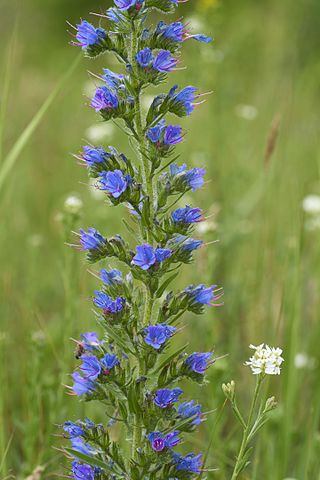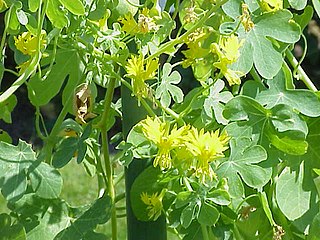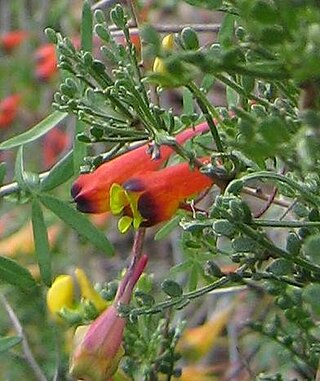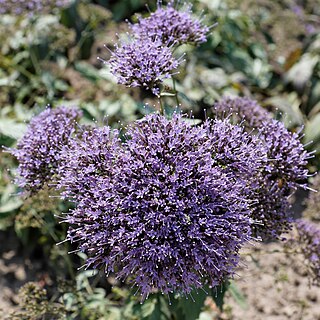
Kiwifruit or Chinese gooseberry is the edible berry of several species of woody vines in the genus Actinidia. The most common cultivar group of kiwifruit is oval, about the size of a large hen's egg: 5–8 centimetres in length and 4.5–5.5 cm in diameter. It has a thin, fuzzy, fibrous, tart but edible light brown skin and light green or golden flesh with rows of tiny, black, edible seeds. The fruit has a soft texture with a sweet and unique flavour.

Tropaeolum, commonly known as nasturtium, is a genus of roughly 80 species of annual and perennial herbaceous flowering plants. It was named by Carl Linnaeus in his book Species Plantarum, and is the only genus in the family Tropaeolaceae. The nasturtiums received their common name because they produce an oil similar to that of watercress.

Alstroemeria, commonly called the Peruvian lily or lily of the Incas, is a genus of flowering plants in the family Alstroemeriaceae. They are all native to South America, although some have become naturalized in the United States, Mexico, Australia, New Zealand, Madeira and the Canary Islands. Almost all of the species are restricted to one of two distinct centers of diversity; one in central Chile, the other in eastern Brazil. Species of Alstroemeria from Chile are winter-growing plants, while those of Brazil are summer growing. All are long-lived perennials except A. graminea, a diminutive annual from the Atacama Desert of Chile.

Echium vulgare, known as viper's bugloss and blueweed, is a species of flowering plant in the borage family Boraginaceae. It is native to most of Europe and western and central Asia and it occurs as an introduced species in north-eastern North America, south-western South America and the South and North Island of New Zealand. The plant root was used in ancient times as a treatment for snake or viper bites. If eaten, the plant is toxic to horses and cattle through the accumulation of pyrrolizidine alkaloids in the liver.

Ulex europaeus, the gorse, common gorse, furze or whin, is a species of flowering plant in the family Fabaceae, native to the British Isles and Western Europe.

Tropaeolum peregrinum, the canary-creeper, canarybird flower, canarybird vine, or canary nasturtium, is a species of Tropaeolum native to western South America in Peru and possibly also Ecuador.

Lavandula angustifolia, formerly L. officinalis, is a flowering plant in the family Lamiaceae, native to the Mediterranean. Its common names include lavender, true lavender and English lavender ; also garden lavender, common lavender and narrow-leaved lavender.

Mandevilla laxa, commonly known as Chilean jasmine, is an ornamental plant in the genus Mandevilla of family Apocynaceae.

Tropaeolum majus, the garden nasturtium, nasturtium, Indian cress or monk's cress, is a species of flowering plant in the family Tropaeolaceae, originating in the Andes from Bolivia north to Colombia. An easily-grown annual or short-lived perennial with disc-shaped leaves and brilliant yellow, orange or red flowers, it is of cultivated, probably hybrid origin. It is not closely related to the genus Nasturtium.

Verbena bonariensis, the purpletop vervain, clustertop vervain, Argentinian vervain, tall verbena or pretty verbena, is a member of the verbena family cultivated as a flowering annual or herbaceous perennial plant. In USA horticulture, it is also known by the ambiguous names purpletop and South American vervain. For the misapplication "Brazilian verbena" see below.

Teucrium fruticans is a species of flowering plant in the mint family Lamiaceae, native to the western and central Mediterranean. Growing to 1 m (3 ft) tall by 4 m (13 ft) wide, it is a spreading evergreen shrub with arching velvety white shoots, glossy aromatic leaves and pale blue flowers in summer.

Lycianthes rantonnetii, the blue potato bush or Paraguay nightshade, is a species of flowering plant in the nightshade family Solanaceae, native to South America. Growing to about 6 ft (1.8 m) tall and broad, it is a rounded evergreen shrub with a somewhat lax habit. A profusion of trumpet-shaped, bright blue-purple flowers with a prominent yellow eye appear in summer, followed by red berries. It is widely cultivated and may be hardy in mild or coastal areas. Alternatively it can be grown in a container and brought under cover in winter. It requires a sheltered location in full sun. Though related to food plants like the potato and tomato, all parts of the plant are considered toxic to humans.

Ribes speciosum is a species of flowering plant in the family Grossulariaceae, which includes the edible currants and gooseberries. It is a spiny deciduous shrub with spring-flowering, elongate red flowers that resemble fuchsias, though it is not closely related. Its common name is fuchsia-flowered gooseberry. It is native to central and southern California and Baja California, where it grows in the scrub and chaparral of the coastal mountain ranges.

Veronica salicifolia, synonym Hebe salicifolia, the koromiko, or willow-leaf hebe, is a flowering plant in the family Plantaginaceae, which is found throughout the South Island of New Zealand and in Chile. It is a large, evergreen shrub, reaching 2 m in height, with light-green, spear-shaped leaves that are up to 12 cm long, and white or pale lilac flowers.

Colchicum speciosum is a species of flowering plant in the family Colchicaceae, native to mountainous areas of northern Turkey, the Caucasus and northern Iran. Growing to 18 cm (7 in) tall by 10 cm (4 in) wide, it is an herbaceous perennial growing from corms. C. speciosum blooms in the fall, producing reddish/violet flowers on stems up to 30 centimetres (12 in) tall without any leaves present. The strap-like leaves grow in the spring, then yellow, wither and die back as summer progresses. The flowers strongly resemble those of the crocus, the familiar spring-flowering bulb; hence the common name autumn crocus which is applied to this and other colchicum species. However the two genera belong to different families; and there is in fact an autumn-flowering crocus species, Crocus sativus, the source of the spice saffron. By contrast, all parts of Colchicum speciosum are toxic if ingested.

Tropaeolum tricolor, the three-coloured Indian cress or Chilean nasturtium, is a species of perennial plant in the family Tropaeolaceae. It is endemic to Chile, where it is called soldadito rojo and relicario.

Tropaeolum polyphyllum is a species of flowering plant in the nasturtium family Tropaeolaceae. It is endemic to mountainous regions of Chile and Argentina where it is called in Spanish soldadito grande de la cordillera.

Trachelium caeruleum, common name blue throatwort, is a species of flowering plant in the family Campanulaceae native to the Mediterranean, where its native range includes Algeria, Morocco, Portugal, Spain, and Sicily. It has also become naturalized in a few areas, including New Zealand, the Azores, and parts of mainland Europe.

Jovellana is a genus of flowering plants in the family Calceolariaceae. It was formerly included in Scrophulariaceae, and is still listed by some authorities as belonging there. However, recent molecular research indicates that the family Scrophulariaceae was polyphyletic, meaning that it contained more than one lineage with different parents. So several of its genera - including Jovellana - have been split off and assigned to new or existing families.
Tropaeolum beuthii is a species of flowering plant in the family Tropaeolaceae, native to Northern Chile. Growing to 1 m (3.3 ft) in height, it is a tuberous summer-dormant climber. It belongs to the same genus as the more familiar annual nasturtium of gardens, Tropaeolum majus.



















